Learn how to make easy and delicious homemade mozzarella cheese. This mozzarella recipe only takes about 30 minutes from start to finish, and it is super delicious. Creamy, salty, all the best things when it comes to cheese.
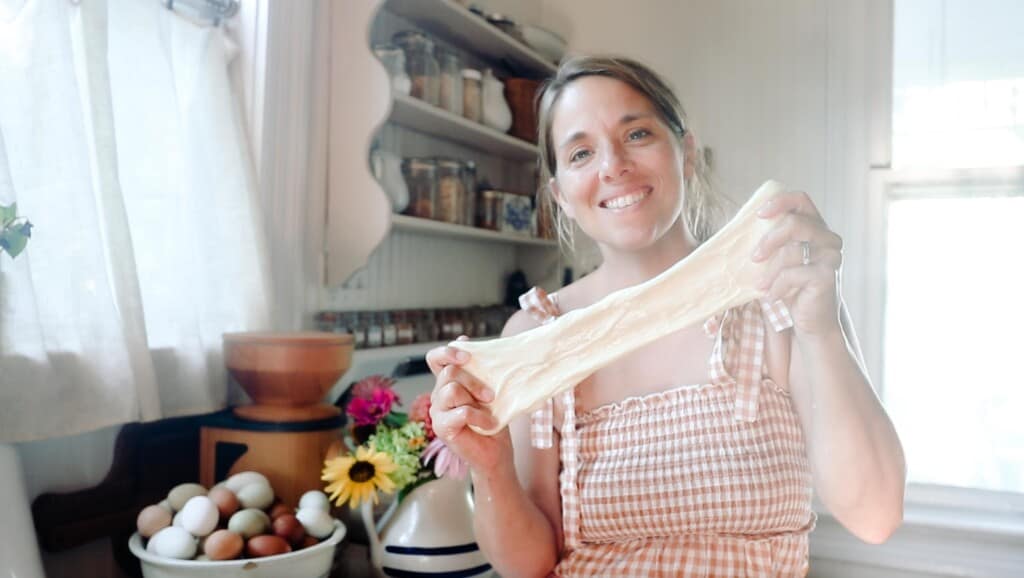
Our dairy cow June is about one year past freshening, and she is still producing more milk that we can just drink. As the milk jars keep piling up, we want to do something with all that milk.
Homemade mozzarella cheese is one of the easiest cheeses to make, and it can be done all in one day. Thirty minutes to be exact!
I used raw, skimmed milk to make this recipe. As in, cream is skimmed off the top. So, not only are you left with cheese, but also the whey that can be used in a variety of ways (like smoothies, soups, ferments, or just to feed the pigs), as well as cream to make butter.
Nothing goes to waste here.
I know many people don’t have a dairy cow in the backyard, but thankfully with this recipe, you can also used store-bought milk. It’s so simple to make mozzarella at home, and it is delicious on pizzas, salads, focaccia…you name it.
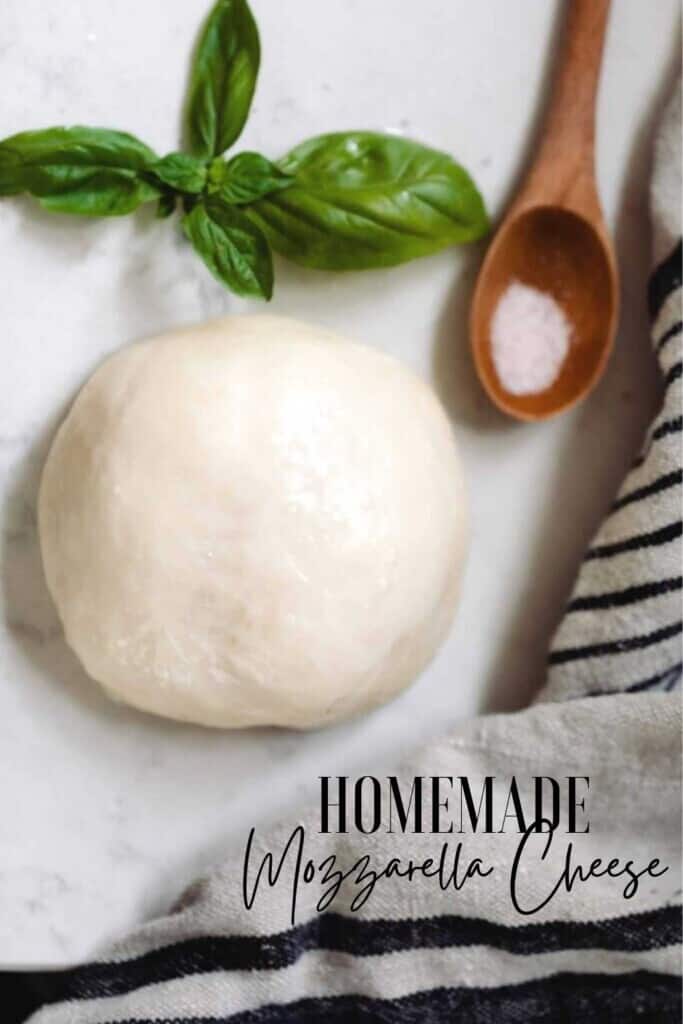
Why you will love this recipe:
Quick: It takes about 30 minutes to make from start to finish. It is one of the fastest homemade cheeses you can make.
Delicious: Creamy mozzarella cheese melted on homemade pizza…or gooey sourdough grilled cheese. Is there anything more delicious?
Great way to use a lot of extra milk: If you have a dairy cow and just have oodles of milk in the fridge or you find a great deal on milk and stock up, it is a great way to use up all that milk.
Nothing goes to waste: The cream skimmed off can be made into butter, the milk solids made into cheese, and the whey can be used in soups, smoothies, or be fed to the pigs or chickens (for non-homogenized milk).
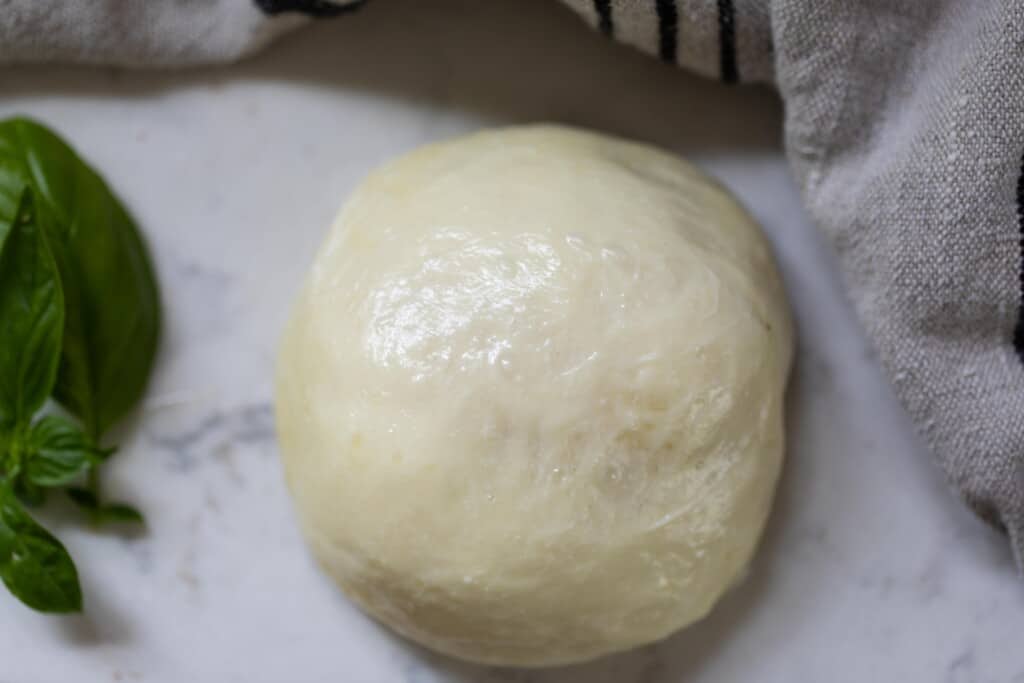
Mozzarella Cheese Making Tips:
- Fresher milk seems to make the cheese a little prettier when heating and cutting the curds, whereas slightly older milk will work just fine (not spoiled), but looks a little funny in the pot.
- I like to heat my milk to around 100 degrees to help keep some of the beneficial things in the raw milk intact. Heating it too high will kill all the glories of raw milk.
- Do not mix the milk too much after the rennet is added. You want to bring the spoon up and down rather than mixing in a circle.
- You can pour the citric acid and the liquid animal rennet right into the milk, but I find it easier to work with if it is already dissolved.
- This recipe easily doubles. I will just use two separate pots.
This post contains affiliate links, which means I make a small commission at no extra cost to you. See my full disclosure here.
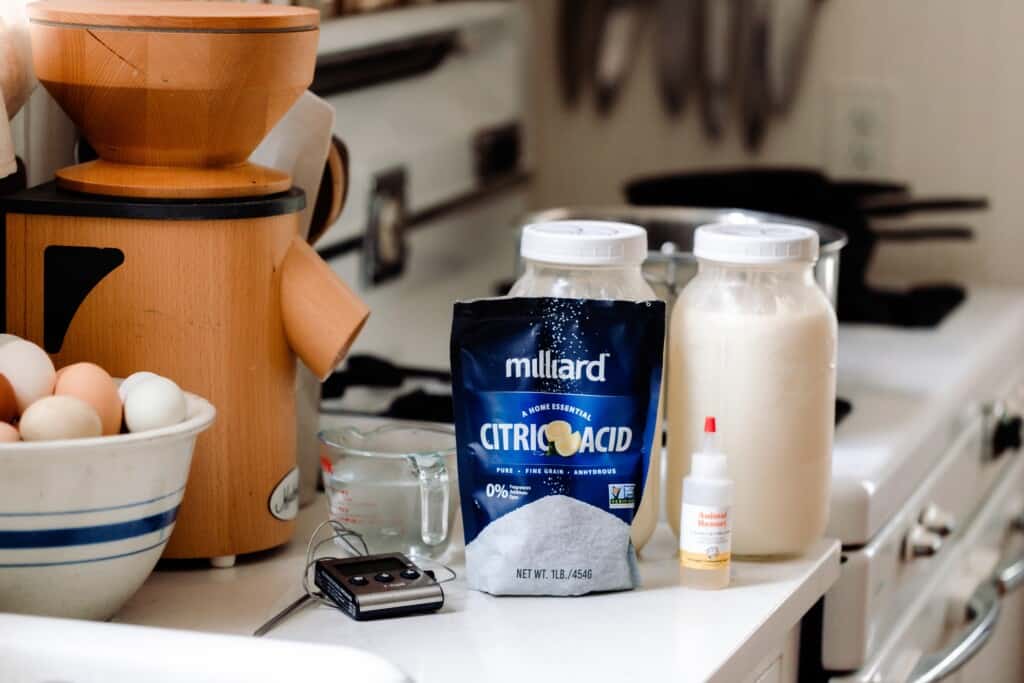
Ingredients:
Milk: I use raw milk with the cream skimmed off the top from our dairy cow. You can also use store-bought whole or 2% milk. Pasteurized milk is fine, but don’t use ultram-pasteurized milk.
Citric acid: This raises the acidity of the milk, which helps separate the curds and whey and makes it stretchy. You can also use lemon juice or vinegar. Citric acid tends to give a more consistent result.
Animal rennet: This ingredient helps solidify the proteins naturally found in milk. It can be found in a liquid and a tablet.
Salt: Preferably sea salt or pink Himalayan. Salt adds so much delicious flavor.
Tools Needed:
Thermometer: This is for bringing the milk up to a specific temperature without it being too hot. We don’t want to scald the milk or kill off all the good stuff (if using raw).
Large pot: For making the cheese and during the stretching and folding stage.
Measuring spoons: To measure out the citric acid and rennet.
Colander: For draining the curds from the whey.
Knife: To cut the curds.
Cheese cloth: This is optional, but can be helpful when straining the curds and pressing.
Large spoon: To mix the milk together and for stirring the curds.
Rubber gloves: Another optional tool, but many people find it necessary for stretching and folding the hot cheese.
How To Make Mozzarella Cheese
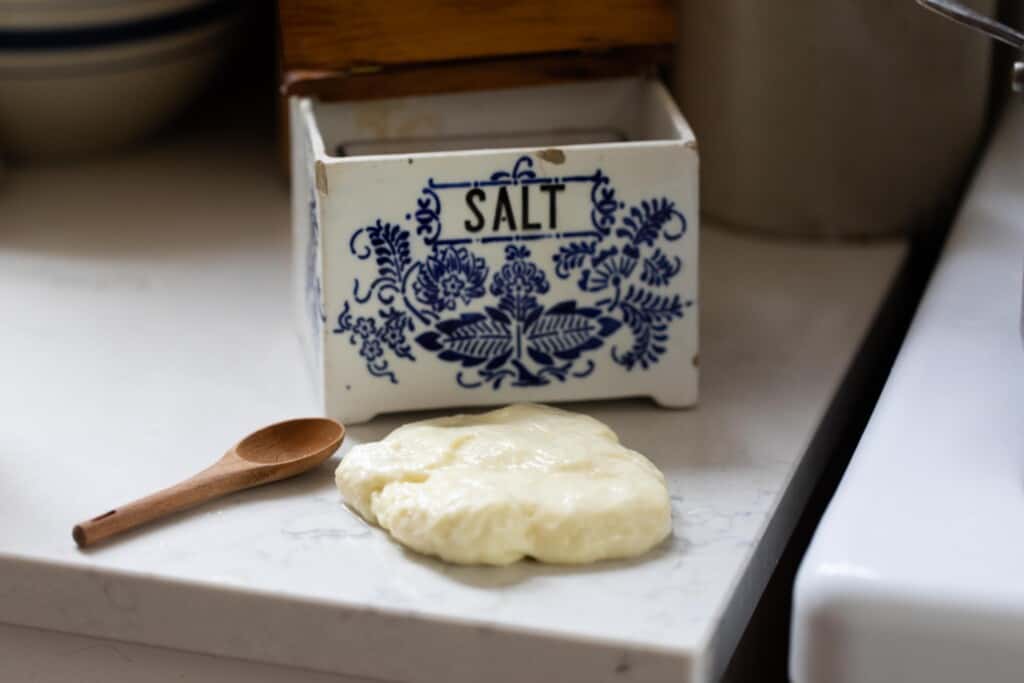
Prepare the citric acid and rennet mixtures
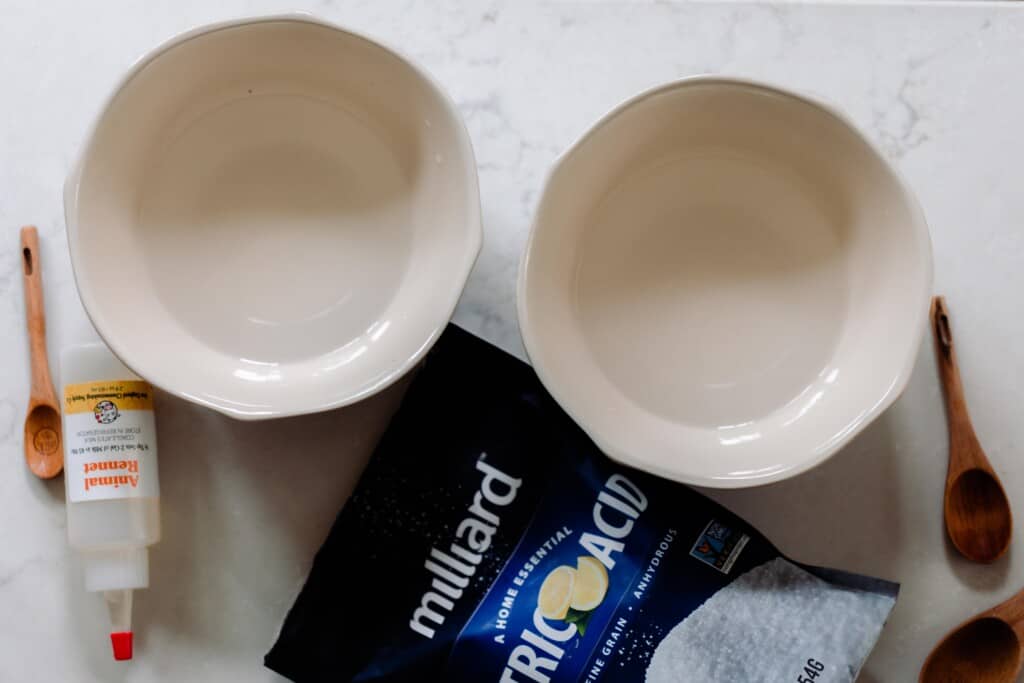
In a small bowl, add the citric acid to water and mix.
In a separate small bowl, mix together water and rennet. Set aside.
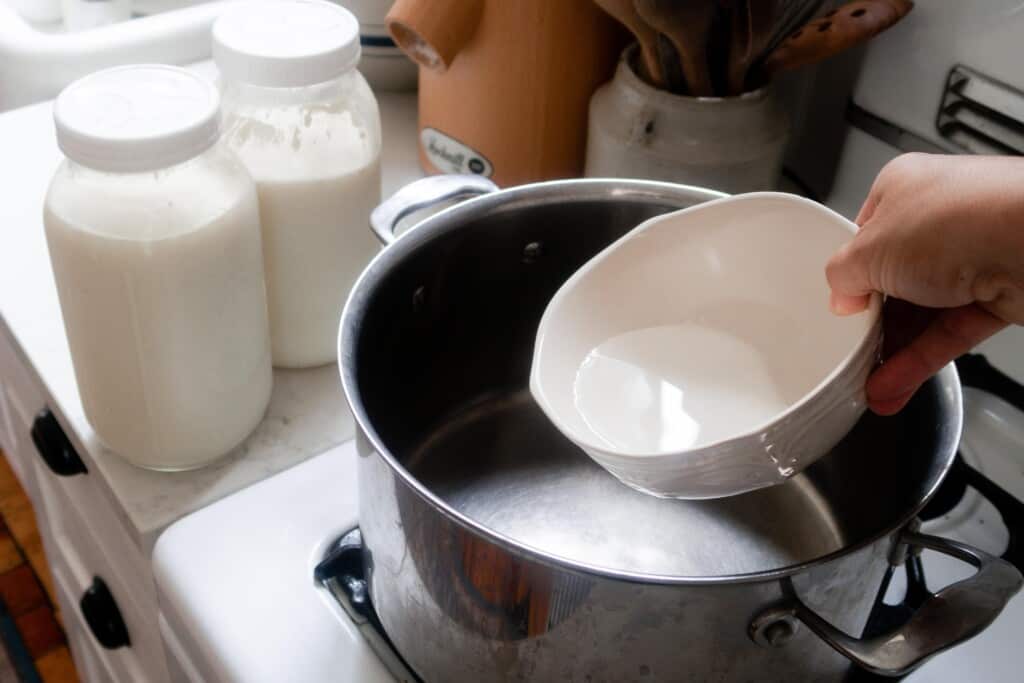
Pour the citric acid mixture into the pot.
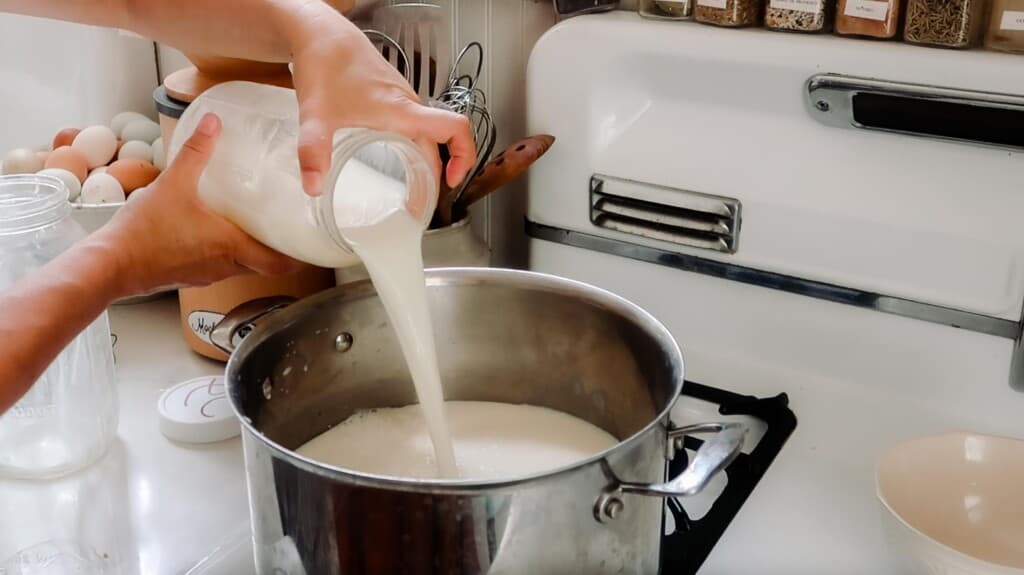
Add milk to the pot and heat to 100 degrees using a digital thermometer.
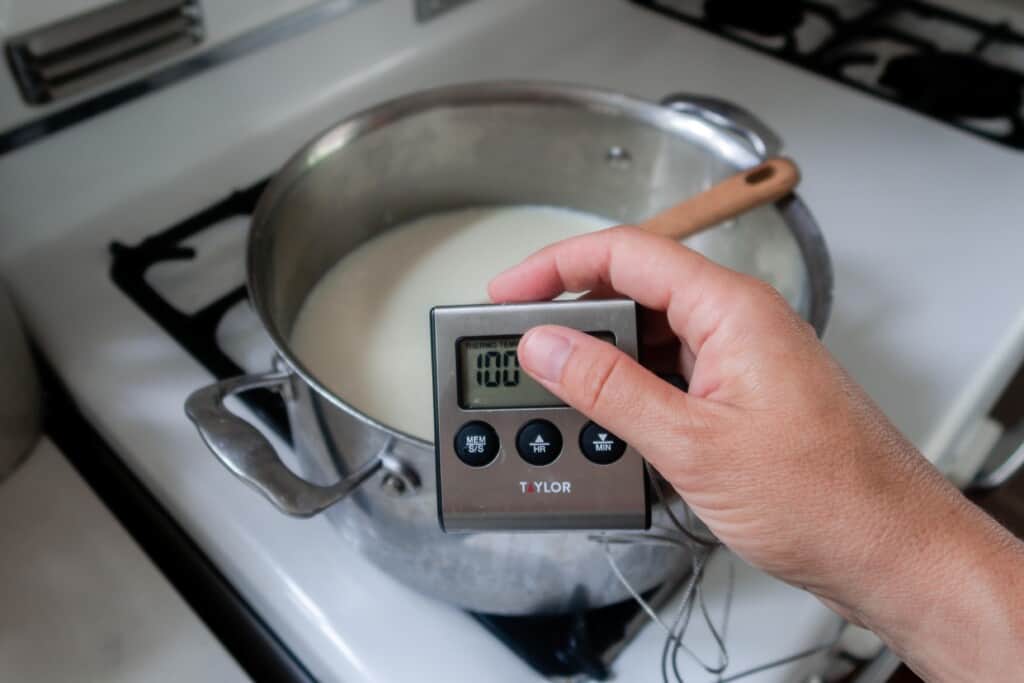
Once it hits 100 degrees, remove from the heat.
Add the Rennet
Mix the animal rennet with water, then add into the pot of milk.
Mix well, making sure to get it all the way to the bottom of the pot, while not agitating it too much.
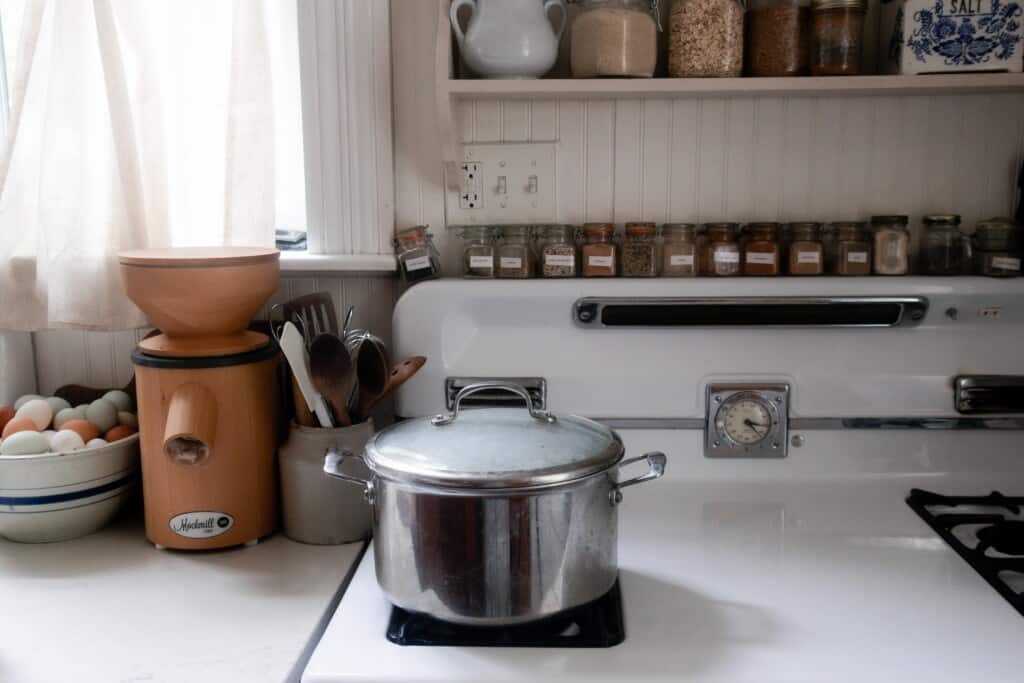
Stir the milk and add a lid. Allow it to sit for ten minutes.
Cut the Curds
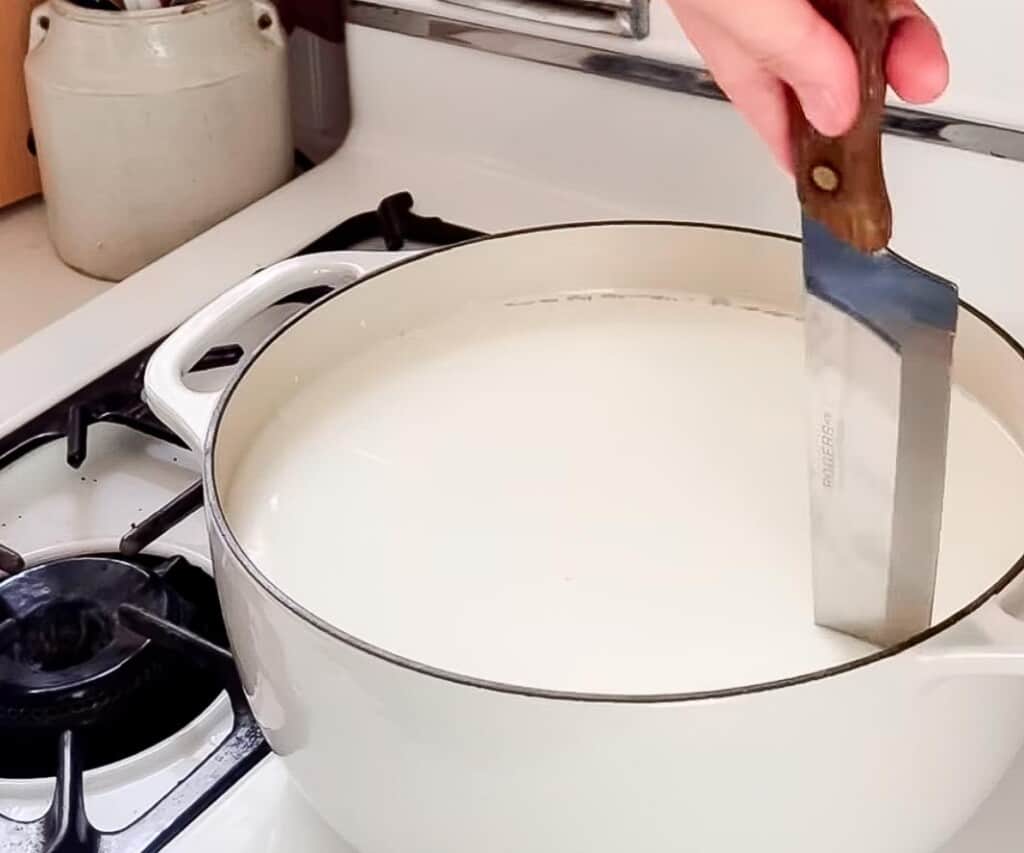
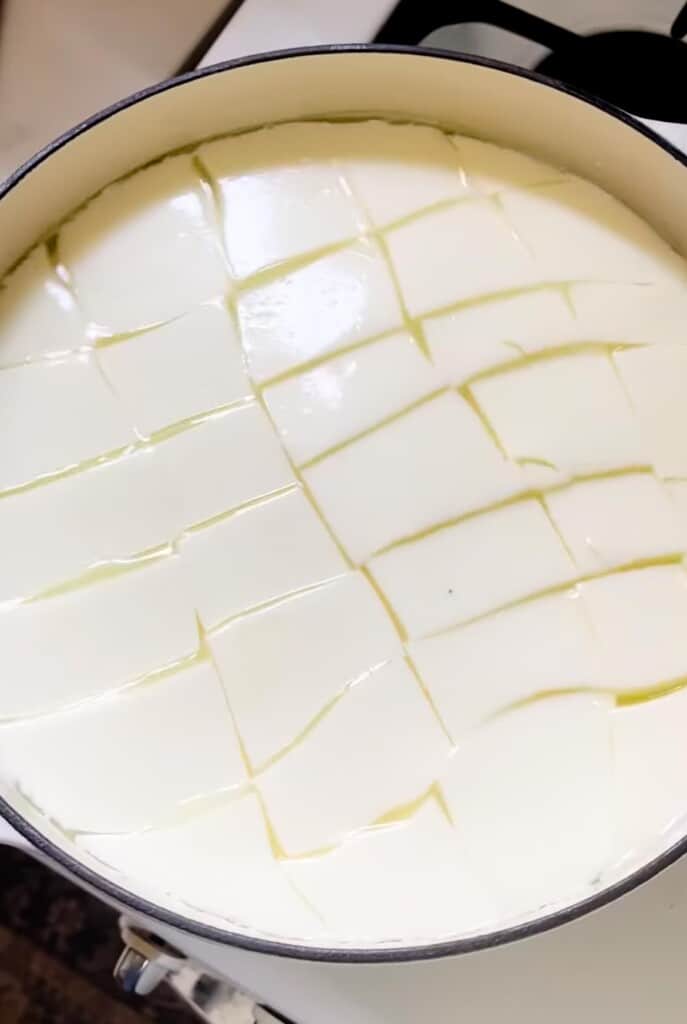
Cut the curds using a large knife, while making sure to get all the way down to the bottom of the pot. Cut in a grid shape.
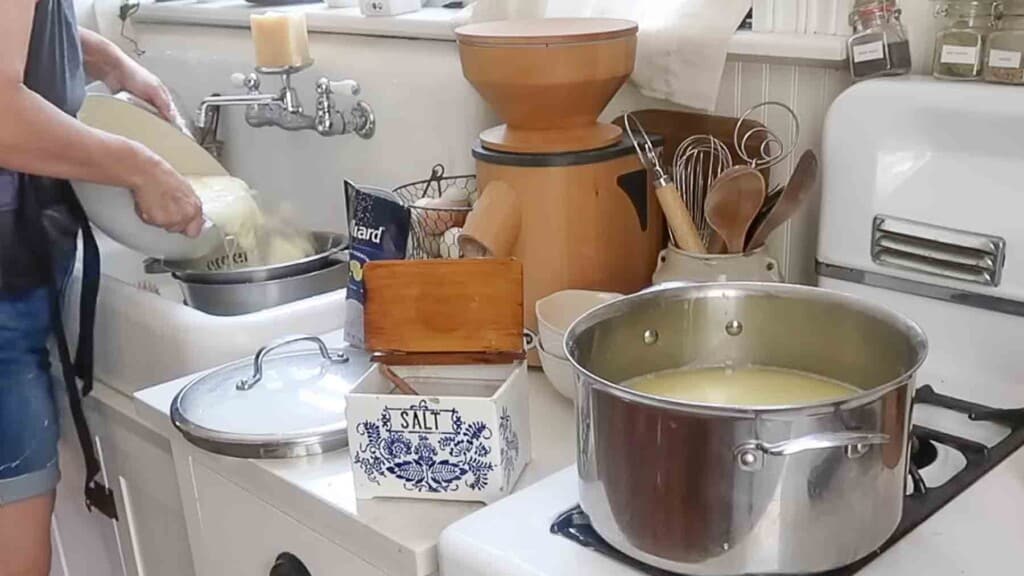
Pour the curds and whey into a colander over a pot, straining off the whey. If you aren’t planning to use the whey for anything, you’ll want to save a little bit of the whey for storing the cheese.
I like to run my fingers through the curds and whey in the colander to help separate and help the whey strain.
Press the Curds
Press out any excess whey with your hands.
Continue pressing until all the of the whey is out of the cheese.
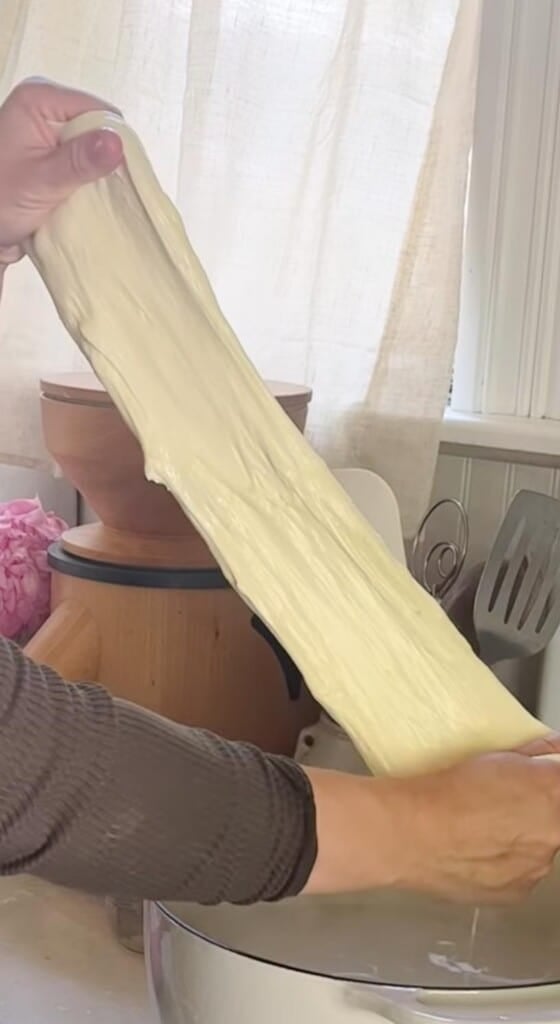
Once the ball of cheese forms and the whey is pressed out, dip the cheese back into hot water and stretch it. (You could also heat it up in a microwave.) I usually dunk the cheese into the hot water and stretch, continuing to do this until the cheese because firm and shiny.
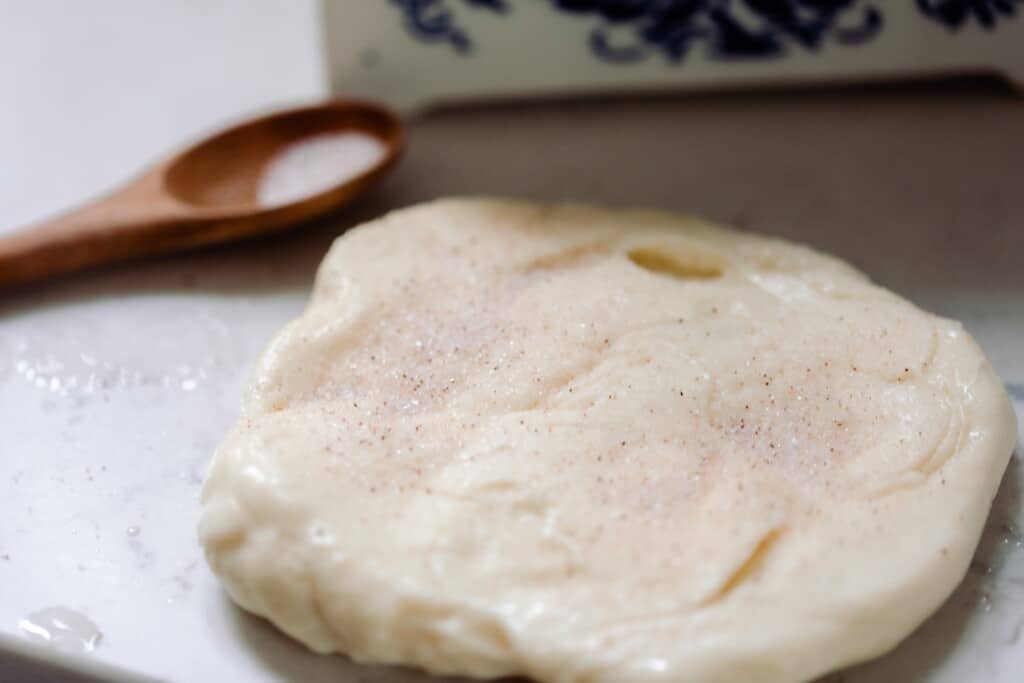
Stretch it a few more times and add salt to taste. I like to hold the cheese with one hand and then sprinkle over the salt in another hand. Fold the cheese over, stretch a few times and add more salt.
Roll into balls and use it right away or store for later.
Storing Homemade Mozzarella
Store in an air-tight container with some of the leftover whey for up to a week. Freeze for up to six months.
How To Use Fresh Mozzarella
- Salads
- Pizza: Sourdough is our go-to, but also love making this einkorn pizza crust.
- Caprese salad
- Brushetta
- Sourdough skillets
- Carnitas
- Soups like cheeseburger, tomato, chicken corn chowder, and more.
- Grilled cheese
- Garlic cheese bread
- Lasagna
- Top homemade pasta
- Sausage and apple stuffed acorn squash
- Sausage Zucchini Boats
- Pesto Gnocchi
- Meatball Subs
- Sourdough breakfast strata
- Stuffed Bell Peppers
FAQ:
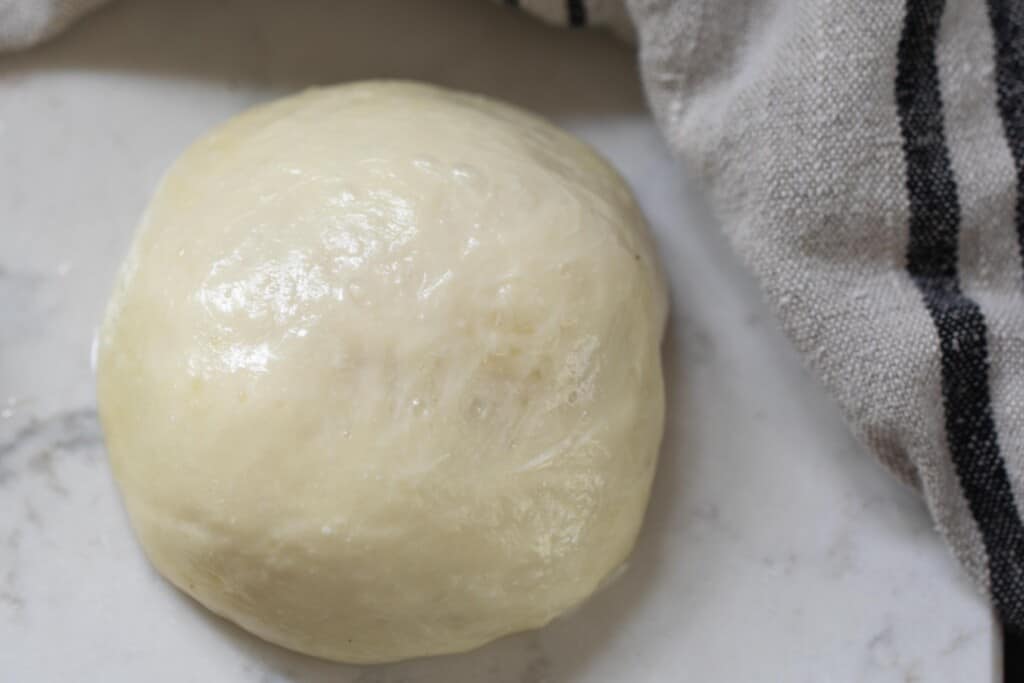
Is it cheaper to make mozzarella at home?
This will obviously be dependent on the type and quality of milk. Store-bought milk can range from $2-7 a gallon, depending on stores, whether it’s grass-fed, organic, etc.
Raw milk is anywhere from $8-22 a gallon.
Can I use vinegar instead of rennet to make mozzarella cheese?
No. If you want to make the real deal stretchy mozzarella, then you will need to use rennet. Substituting white vinegar for rennet will leave you with more of a farmers cheese. There is a way to make it somewhat like mozzarella, but it will be more crumbly and not stretchy.
How long does it take to make mozzarella cheese?
It takes about 30 minutes from start to finish to make this recipe. It is super easy and a great way to use up extra milk.
Find More Recipes From Our Farmhouse:
- Sourdough Vanilla Cake
- Creamy Pumpkin Pasta Sauce Recipe
- Sourdough Biscotti
- One Skillet Creamy Peach Chicken
- Brioche French Toast Recipe
If you try this recipe and love it, I would love if you gave it 5 stars! Thank you! Tag me on Instagram @farmhouseonboone.
Homemade Mozzarella Cheese
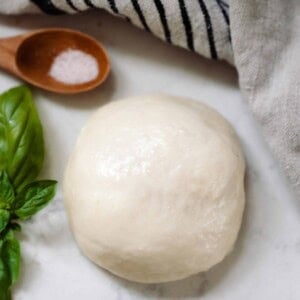
Ingredients
- 1 1/2 teaspoons citric acid
- 1/4 teaspoon animal rennet
- 1/2 cup water, divided
- 1 gallon whole milk
Instructions
- In a small bowl, add the citric acid and 1/4 cup of the water. Stir to dissolve.
- In a separate small bowl, mix together the remaining 1/4 cup of water and rennet. Set aside.
- Pour the citric acid mixture into a large pot.
- Add the milk to the pot and heat over medium, stirring constantly to incorporate the citric acid.
- Once the milk and citric acid mixture reaches 100° F, using a digital thermometer, remove the pot from the heat. If you are using a gas stove, it is fine to leave the pot on the burner as long as the flame is off.
- Add the rennet/water mixture into the pot of milk. Mix well, making sure to get it all the way to the bottom of the pot, while not agitating it too much. Sometimes I stir clockwise and then quickly switch to counter-clockwise to still the milk. You want the milk to be pretty still for the next step.
- Put a lid on the pot and allow it to sit for ten minutes, or until the curds have set. If tak off the lid and it looks like the milk is still pretty watery, you can return the lid and do some other tasks around the kitchen.
- Once the curds have set, cut them using a large knife, while making sure to get all the way down to the bottom of the pot. Cut in a grid shape.
- Pour the curds and whey into a colander over a pot, straining off the whey. If you aren’t planning to use the whey for anything, you’ll want to save a little bit of the whey for storing the cheese.
- Press out any excess whey with your hands.
- Continue pressing until all the of the whey is out of the cheese.
- Once the ball of cheese forms and the whey is pressed out, dip the cheese back into hot water and stretch it. (You could also heat it up in a microwave.) I usually dunk the cheese into the hot water and stretch, continuing to do this until the cheese because firm and shiny.
- Stretch it a few more times and add salt to taste. I like to hold the cheese with one hand and then sprinkle over the salt in another hand. Fold the cheese over, stretch a few times and add more salt.
- Roll into balls and use it right away or store for later.
Notes
- Fresher milk seems to make the cheese a little prettier when heating and cutting the curds, whereas slightly older milk will work just fine (not spoiled), but looks a little funny in the pot.
- I like to heat my milk to around 100 degrees to help keep some of the beneficial things in the raw milk intact. Heating it too high will kill all the glories of raw milk.
- Do not mix the milk too much after the rennet is added. You want to bring the spoon up and down rather than mixing in a circle.
- You can pour the citric acid and the liquid animal rennet right into the milk, but I find it easier to work with if it is already dissolved.
Nutrition
Nutrition information is automatically calculated, so should only be used as an approximation.




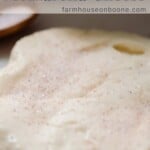












It was very nice! Thank you!
Here is a questions that I have …
How much cheese we can earn per 1 kilogram of milk?
It takes about 10 liters of milk to produce 1 kg of cheese!
Just want to say thank you! It was greate …
What are the options we can di with Whey?!
I like to add it to smoothies for extra benefits!
I made this today with whole pasteurized milk, vat homogenized and it did not set up even though I followed the recipe perfectly. I see a comment below that says raw milk only but the instructions say pasteurized store bought milk is okay. Can you only use raw milk for this recipe?
This should be fine because it was VAT pasteurized, which is at a lower temperature. Usually the problem occurs if it is traditionally pasteurized where they heat the milk up too high. It loses its ability to set.
Can I used homogenized milk( like what you find on the grocery store shelves or does it have to be raw milk
It really needs to be raw!
You said to use the whey to store it. How do I go about doing that?
I like to put it in a glass container in the fridge.
Can you make butter out of the remaining milk?
No, butter is made from cream.
Mine didn’t curd up at all 😭 I want to cry bc it was a half week of goat milk. Wonder why ot didn’t work out. Fresh rennet and Everything. It is like milk still.
Hi, been following a while. I just recently dove off the deep end from not eating gluten and dairy due to reactions to now eating sour dough and raw milk. We are lucky to have an A2 raw milk farm in driving distance. BUT my milk drinking peeps aren’t so keen on the change. I however am excited! Anyway, I have a quart of milk thats starting to sour. I know not to throw it out but I’m stuck. I’m not sure what to do with it since I don’t have any cultures for milk stuff yet. I do have animal rennet on the way because I really want to make mozerella…pizza…im so excited. Haha! Can you give me an idea on what to do with it until I get a culture for yogurt or sour cream. I dont have an instapot but I do have a crockpot. Is there a way to make anything without cultures? Sorry so long. I know you don’t know me from Eve but your information and presence in my life have been, well, life changing!
I usually use it to make smoothies because that disguises the tang flavor.
You can make cottage cheese!! We did this for the first time recently because we were in the same boat & it was very easy & you don’t need anything extra.
Hi Denise and any others out there who love yogurt. You don’t need to buy cuktures to make your own yogurt. Just use some Plain, unsweetened yogurt from the store as a starter. * As long as it says ‘contains live probiotics or cultures’ on the container, you’re good to go. I learned this recipe/method from a 3 1/2 year old child in Finland’s Lapland many years ago. This was the childs daily chore, making yogurt for the following dats breakfast. Leave whatever milk you pkan to use sitting out on the counter at least 4-6 hours. When you’re ready spread spread a good amount of your TEPID yogurt all over the sides and bottom of your dish, pour in the milk(don’t stir it). Cover and leave it in a warm spot. Some hours later…viola!
* Not sure of the exact number of hours til it’s ready due to variables.
How many ozs does a batch make?
I found you on YouTube while researching different cfeese recipes. On there you said that after making mozzarella that you used the whey to make ricotta. O you have directions or instructions for that? I’d really like to use the whey for that purpose because we have so much milk! I’m just not sure how. Thank you
I don’t yet. I need to make a blog post about that.